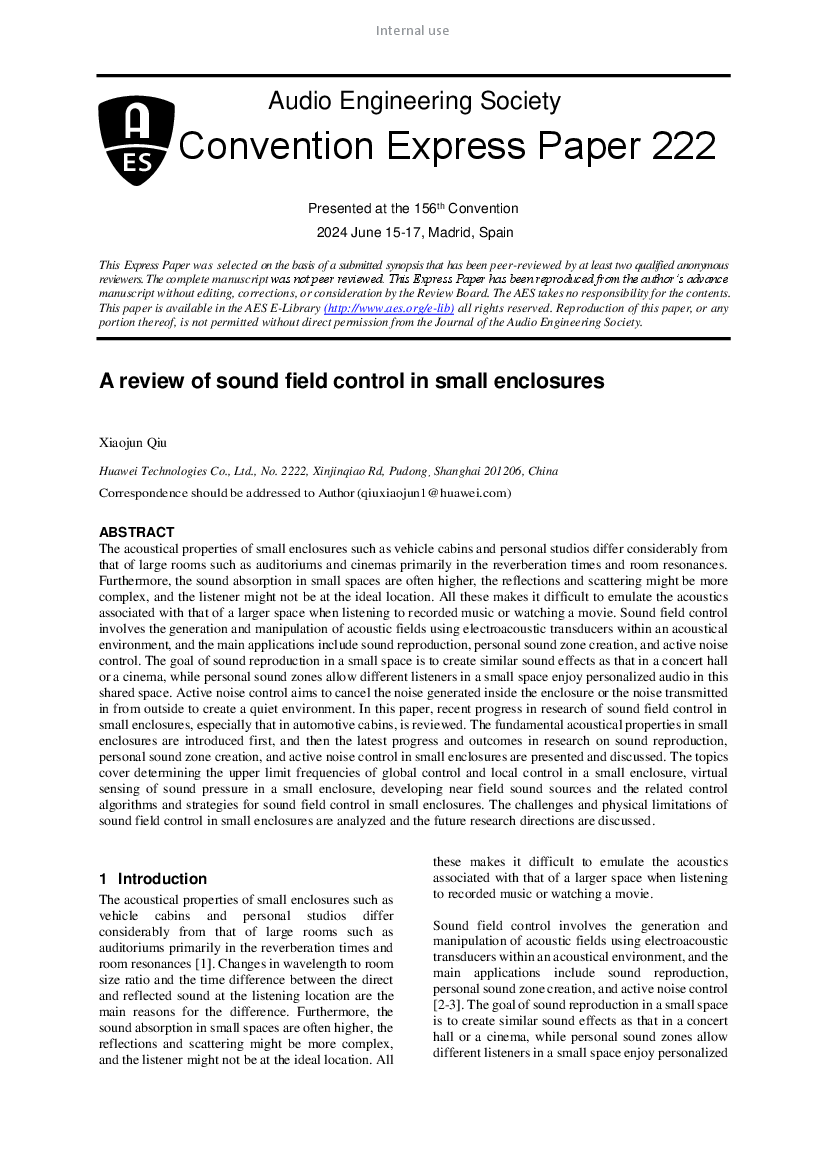Home / Publications / E-library page
You are currently logged in as an
Institutional Subscriber.
If you would like to logout,
please click on the button below.
Home / Publications / E-library page
Only AES members and Institutional Journal Subscribers can download
The acoustical properties of small enclosures such as vehicle cabins and personal studios differ considerably from that of large rooms such as auditoriums and cinemas primarily in the reverberation times and room resonances. Furthermore, the sound absorption in small spaces are often higher, the reflections and scattering might be more complex, and the listener might not be at the ideal location. All these makes it difficult to emulate the acoustics associated with that of a larger space when listening to recorded music or watching a movie. Sound field control involves the generation and manipulation of acoustic fields using electroacoustic transducers within an acoustical environment, and the main applications include sound reproduction, personal sound zone creation, and active noise control. The goal of sound reproduction in a small space is to create similar sound effects as that in a concert hall or a cinema, while personal sound zones allow different listeners in a small space enjoy personalized audio in this shared space. Active noise control aims to cancel the noise generated inside the enclosure or the noise transmitted in from outside to create a quiet environment. In this paper, recent progress in research of sound field control in small enclosures, especially that in automotive cabins, is reviewed. The fundamental acoustical properties in small enclosures are introduced first, and then the latest progress and outcomes in research on sound reproduction, personal sound zone creation, and active noise control in small enclosures are presented and discussed. The topics cover determining the upper limit frequencies of global control and local control in a small enclosure, virtual sensing of sound pressure in a small enclosure, developing near field sound sources and the related control algorithms and strategies for sound field control in small enclosures. The challenges and physical limitations of sound field control in small enclosures are analyzed and the future research directions are discussed.
Author (s): Qiu, Xiaojun
Affiliation:
Huawei Technologies Co., Ltd., Shanghai, China
(See document for exact affiliation information.)
AES Convention: 156
Paper Number:222
Publication Date:
2024-06-06
Import into BibTeX
Permalink: https://aes2.org/publications/elibrary-page/?id=22568
(378KB)
Click to purchase paper as a non-member or login as an AES member. If your company or school subscribes to the E-Library then switch to the institutional version. If you are not an AES member Join the AES. If you need to check your member status, login to the Member Portal.

Qiu, Xiaojun; 2024; A review of sound field control in small enclosures [PDF]; Huawei Technologies Co., Ltd., Shanghai, China; Paper 222; Available from: https://aes2.org/publications/elibrary-page/?id=22568
Qiu, Xiaojun; A review of sound field control in small enclosures [PDF]; Huawei Technologies Co., Ltd., Shanghai, China; Paper 222; 2024 Available: https://aes2.org/publications/elibrary-page/?id=22568